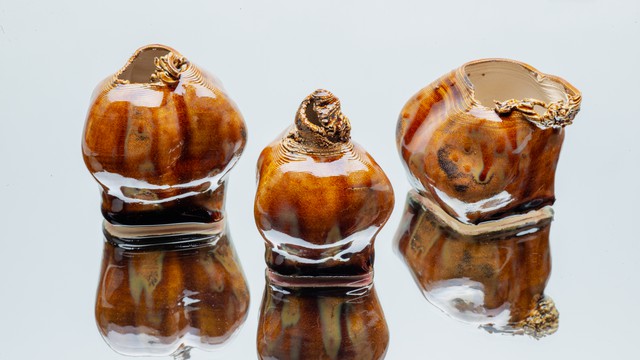Transformative Drift 2023, Germany, Weimar
Exploring the dynamics between A.I.-Sculptures and 3D-Clayprinting




With the Metaverse, NFTs, and the 3rd most valuable living artist Beeple, who nobody ever heard of, more and more the question arises: how much is a piece of art or a property worth in the realm of digital? This project is questioning materiality in the 21st century by showing the value of a physical object while honoring its digital origins. It’s time to say goodbye to old classifications like "online" and "offline" and to start discussing what materiality will mean in the future and how we can deal with future transformations of our constructed world.
Timur SiQuin’s ideas on materialism and evolution in art have captured my imagination. SiQuin argues that even things we see as immaterial, such as a poem or an algorithm, have a materiality because they can have an impact on their environment. I find this idea particularly interesting because it gives digital art a value that is still often denied to it. I support Si Quins thesis, but I still chose to make my immaterial 3D work physically experiential by 3D printing it. I choose clay printing because working with an organic material felt more natural and fitting with the concept itself. I was drawn to an organic materials and physic simulations - which are also kind of “organic” - for some time. My work always centered around a process at the intersection of digital and analog. Lately, I realized that organic influences are more relevant to me than just experimenting with analog and digital formats. “It is never the artist alone who gives form to a material, but the dialogue between artist and material.” This quote was the foundation for my practical work. It applies not only to physical production but also the usage of algorithms or plugins, which also have their limits in influencing the outcome. SiQuin sees evolution more as coevolution and connectivity, rather than the traditional “survival of the fittest” narrative. This gave me new thoughts on evolution and if it could be simulated as an organic factor in art. “Darwin’s remarkable insight reveals how a random iterative process can act on an initial set of conditions to continually improve an organism’s fitness.” This is a very broad definition of evolution after Darwin but it helped me to further develop the idea of making the artwork itself a random iterative process. This connects back to the concept of glitchart, where the process, mostly ignored in favour of the finished artwork, becomes the artwork itself. This shift in focus makes the unseen visible and highlights the process as art, which is a metaphor for my experience in this course in general. This also suggests that the artwork itself is never finished and we only see it’s current state. Umberto Eco called this the “open work.” From a media archaeological perspective, the analysis of these ontic operations and processes is valuable because it illuminates the gaps between one medium and another while making visible the material differences in their systems of meaning. Laric‘s artistic enterprise addresses these questions through recursive, self-referential chains of operations that show how signs become information and how this information is in turn processed, transformed, stored, and transmitted from one medium to another. I took the recursive self-referential chains of operations and combined it with the idea of evolution or ontogenesis to create my sculptures. For more details on the sculptures consult the “Transformative Drift” booklet available in the link below.
https://issuu.com/zsagar/docs/tz_booklet_process
Poster
Details
Team members : Torben Zsagar
Supervisor : Prof. Mona Mahal
Descriptions
Technical Concept : My approach involved reading relevant books and articles and producing practical work based on my research. Timur SiQuin’s ideas on materialism and evolution in art inspired me to support his thesis by 3D printing my immaterial 3D work with clay. My work focuses on the intersection of digital and organic materials and the role of algorithms and material in influencing the outcome. Timur SiQuin’s take on evolution as coevolution and connectivity helped me develop the idea of making my work a random iterative process, connecting to glitch art. Furthermore, he shows that every work is defined by the relationship between the viewer and the work and is never finished. The analysis of the recursive, self-referential chains of operations in Oliver Laric’s work influenced me to create sculptures using iterative steps, which were showcased in the go4spring exhibition at Bauhaus-Universität Weimar
Visual Concept : “Darwin’s remarkable insight reveals how a random iterative process can act on an initial set of conditions to continually improve an organism’s fitness.” This is a very broad definition of evolution after Darwin, but it helped me to further develop the idea of making the work itself a random iterative process. This connects back to the concept of glitch art, where the process, mostly ignored in favor of the finished artwork, becomes the artwork itself. This shift in focus makes the unseen visible and highlights the process as art, which is a metaphor for my experience in this project in general. This also suggests that the twork itself is never finished and we only see its current state.
Credits
Torben Zsagar & Richard Schött
Torben Zsagar & Richard Schött
Torben Zsagar & Richard Schött
Torben Zsagar & Richard Schött
Torben Zsagar
Torben Zsagar & Richard Schött